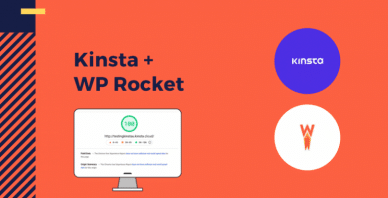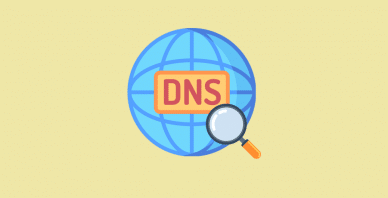Table of Contents
Last update on
Do you want to know which are the best CDNs for WordPress? That’s a smart strategy to improve performance. A Content Delivery Network (CDN) delivers your content faster to users around the world, which means your website loads quickly no matter where your audience is.
On any platform, speed matters, but for WordPress site performance, it’s critical.
Here’s why.
WordPress is an ecosystem where your theme, plugins, and hosting all work together to power your site. While many themes and plugins are built with performance in mind, your site can slow down when certain factors occur: outdated plugins, a “feature-rich” theme stuffed with scripts you don’t use, or a heavy page builder that adds unnecessary code.
In this article, you’ll discover what a CDN is, the key features to look for when choosing a provider, our top picks for the best CDNs for WordPress, and the essential KPIs (with target values) to track your CDN’s performance.
| TL;DR: A Content Delivery Network (CDN) boosts WordPress site performance by delivering content from servers located closer to your visitors, reducing load times and improving user experience. The best CDNs for WordPress combine speed, strong CDN security features, and seamless integration. In this guide, we recommend RocketCDN for easy setup and automatic optimization, Cloudflare for advanced features and security, and Envira CDN for image-heavy sites. To measure your CDN’s impact, track KPIs like TTFB, LCP, and total page loading speed. For the best results, pair your CDN with WP Rocket, the best performance plugin for WordPress. |
Key Takeaways
✅ A CDN improves speed by delivering content from edge servers closer to your users.
✅ Consider budget, PoP locations, performance features, and security when choosing a CDN.
✅ RocketCDN is the easiest choice with no technical setup needed.
✅ Test performance before and after enabling a CDN using KPIs like TTFB, LCP, and page loading speed.
✅ Use GTmetrix to test from different locations, allowing you to measure CDN performance for international visitors far from your origin server.
✅ Avoid mistakes such as complex setups, wrong caching configuration, or ignoring audience location.
✅ A high cache hit ratio (above 90%) is a good sign that your CDN is effective.
✅ Pair the CDN with WP Rocket to ensure faster content delivery and optimized site performance.
What Is a CDN and How It Works
A CDN, or Content Delivery Network, is like having many copies of your website saved on servers all over the world. Instead of getting the content from your origin server, visitors get it from the one closest to them, so the site loads much faster.
Here’s how it works technically:
A CDN has a group of servers distributed around the world (Points of Presence). Instead of delivering the data from your main hosting server (called the origin server), those servers store copies of your site’s static assets, such as images, CSS, and JavaScript, all around the world.
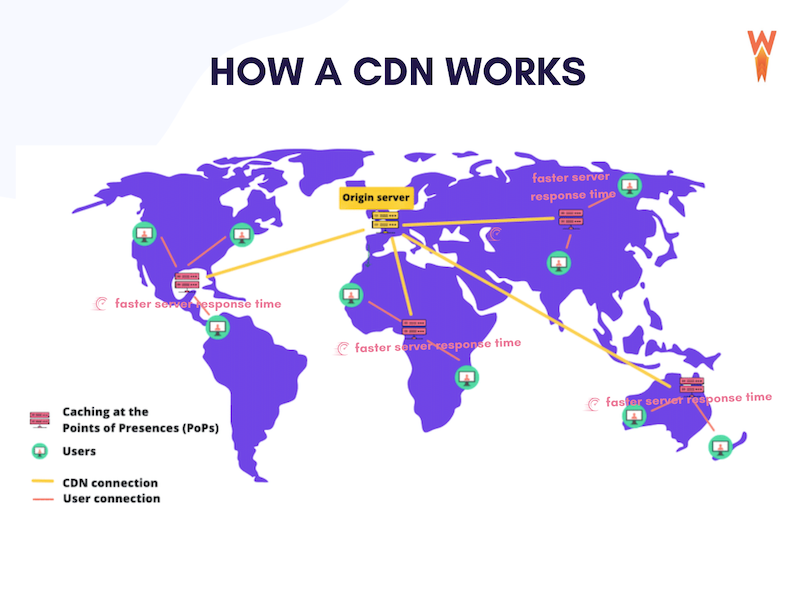
When someone visits your site, the CDN delivers the content from the PoP closest to them, reducing latency and improving load time.
Imagine you run a WooCommerce store selling hats, hosted in Paris. A visitor in Sydney wants to browse your site and make a purchase.
- Without a CDN, their request travels all the way to Paris and back to Sydney. It can take a long time, potentially causing delays in content delivery.
- With a CDN, the request is handled by a server (PoP) in Sydney. Your content “is already there”, making the page load much faster.
| 👨🎓 Quick CDN Glossary PoP (Point of Presence): A location where the CDN has a server that stores cached versions of your site’s assets. Origin server: Your main hosting server where your WordPress files and database are stored. CDN Caching: The process of storing copies of files so they can be delivered faster. Latency: The time it takes for data to travel between the server and the visitor’s browser. |
Best CDN Services for WordPress
If you’re ready to take your WordPress site performance to the next level, here are our top 3 picks for the best CDNs for WordPress: RocketCDN, Cloudflare, and Envira CDN. Each offers strong CDN speed optimization, but with different features, pricing, and ease of use.
1. RocketCDN: Fast and Easy Content Delivery
RocketCDN is built by the same team behind WP Rocket, the best performance plugin for WordPress, whose mission is simple: make the web faster. The CDN was created with two main goals in mind: automatic setup and maximum speed.
Key features:
- Access to 120+ PoPs worldwide.
- Preconfigured performance settings: cache expiration policy, GZIP compression, HTTP/2, and more.
- Unlimited bandwidth with reasonable usage.
- All files are automatically served over HTTPS.
- SSL traffic for secure content delivery.
Configuration tips: No technical setup is required. Simply enter your site URL to apply RocketCDN’s automated settings.
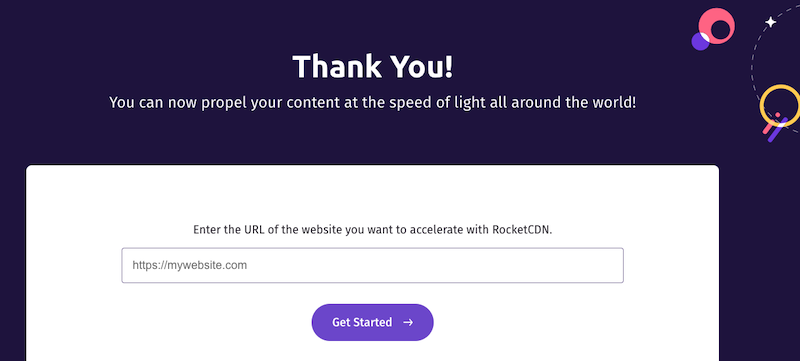
The CDN also comes with a free plugin called the RocketCDN plugin, and it makes activation very easy. Install the plugin, add your API key, and all your site’s static assets will be served through the CDN.
Pricing: €8/month or €81/year.
Pros:
- Extremely easy to use with automatic optimization (no manual configuration needed).
- Free WordPress plugin for quick setup.
- One of the cheapest CDN for WordPress.
Cons:
- Because everything is automatically optimized, there is no advanced dashboard for fine-tuning settings or monitoring.
2. Cloudflare: Powerful Performance and Security
Cloudflare is one of the most popular CDNs in the world, known for its combination of CDN speed optimization and robust CDN security features. It offers a massive global network and is trusted by millions of websites, from personal blogs to enterprise platforms.
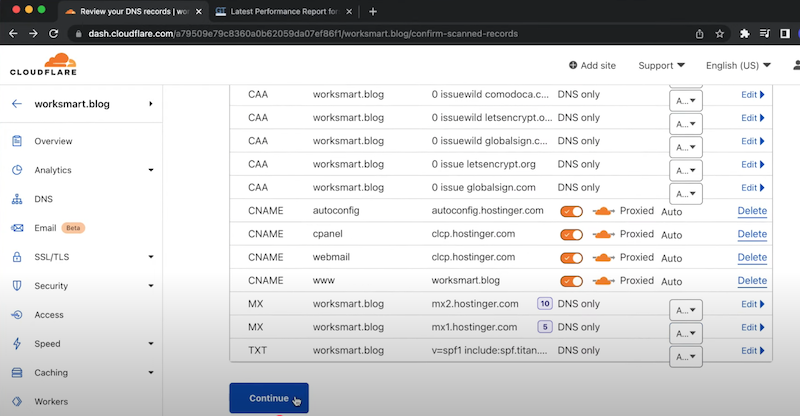
Key features:
- Access to 300+ PoPs across more than 100 countries.
- Built-in DDoS protection, SSL/TLS encryption, and Web Application Firewall (WAF).
- Automatic image optimization (on certain plans).
- HTTP/3 support for faster and more reliable connections.
- Always Online™ technology to keep your site accessible during outages.
Configuration tips:
- The free plan is easy to set up via your domain’s DNS — you can connect it to WordPress without installing extra software.
- For more advanced optimization, use the official Cloudflare WordPress plugin, which allows you to purge cache, enable Automatic Platform Optimization (APO), and tweak settings from your dashboard.
Pricing: Free plan available. Paid plans start at around €20/month for extra features like advanced security, image optimization, and custom rules.
Pros:
- Massive global network with top-tier performance.
- Excellent security features.
- Free plan available.
Cons:
- Some of the best performance features (like APO and advanced image optimization) require a paid plan.
- Setup can be more technical compared to plug-and-play CDNs like RocketCDN.
3. Envira CDN: Optimized for Media-Heavy Sites
Envira CDN is part of the Envira Gallery plugin ecosystem, designed specifically for media-rich WordPress websites. It’s a good choice if you need WordPress site speed improvement for image-heavy pages without complex configuration.
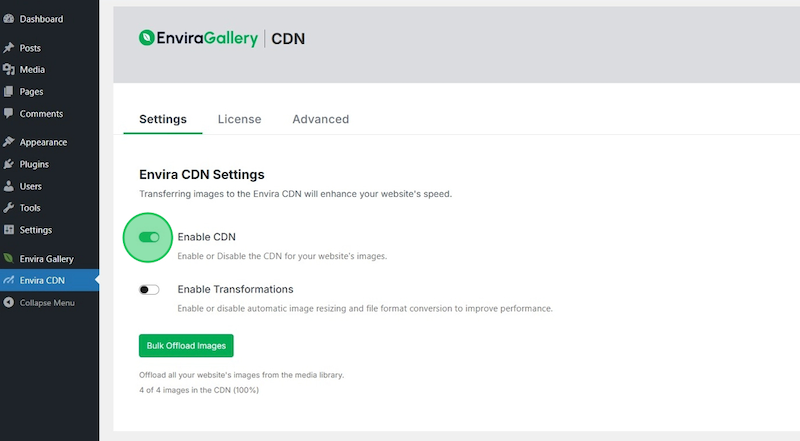
Key features:
- Direct integration with the Envira Gallery plugin for image delivery.
- Global server network optimized for media-rich sites.
- Responsive image delivery to match visitor devices.
- Faster load times for galleries and portfolios.
- Secure delivery of media files over HTTPS.
Configuration tips: If you add your images to Envira Gallery, they’ll be automatically served from the CDN.
Pricing: The CDN subscription is included with certain Envira Gallery plans. Otherwise, pricing starts at around €10/year.
Pros:
- Ideal for photographers, artists, or media-heavy sites.
- Activation is very easy from WordPress, via a plugin.
- Optimized for responsive image delivery.
Cons:
- Envira CDN works mainly for image delivery rather than other static assets like JS or CSS.
What Are the Benefits of Using a CDN for a WordPress Site?
A Content Delivery Network is more than just a speed booster. It improves user experience, strengthens security, and supports your international growth. Here are the main benefits of using a CDN for WordPress.
1. Your Content is Delivered Faster
A CDN improves performance, global reach, and reduces delays. With servers located worldwide, your content is delivered from the PoP closest to each visitor. This reduces latency and ensures faster load times, regardless of your audience’s location.
2. You Improve User Experience and SEO
Faster websites offer a better user experience and can boost SEO rankings. Google uses site speed as a ranking factor. By using a CDN, you improve both search visibility and user satisfaction, especially for international visitors.
3. You Get Built-in Security Features and Protection Against DDoS
A CDN helps protect your site from attacks. By distributing traffic across multiple servers, it can absorb and mitigate DDoS attacks, preventing them from overwhelming your site. Many CDNs also offer SSL/TLS encryption and Web Application Firewalls (WAFs) for extra protection.
| 💡 Hint: Interested in securing your WordPress site? Check out our guide on WordPress security. |
4. You Guarantee Stable Performance During Traffic Spikes
If your site experiences sudden surges in traffic from a promotion, viral content, or seasonal demand, a CDN helps maintain stability by spreading requests across its network. This prevents slowdowns and keeps your WordPress site’s performance consistent.
5. You Reduce the Risks of Downtime
Another benefit of using a CDN is reduced risk of downtime. If your origin server experiences issues, the CDN can continue serving cached content from its network, keeping your site online for visitors.
6. You Reduce Bandwidth Costs
Because a CDN delivers cached content from nearby PoPs, less data is pulled from your origin server. This can significantly lower bandwidth usage and hosting costs, especially for media-heavy WordPress sites.
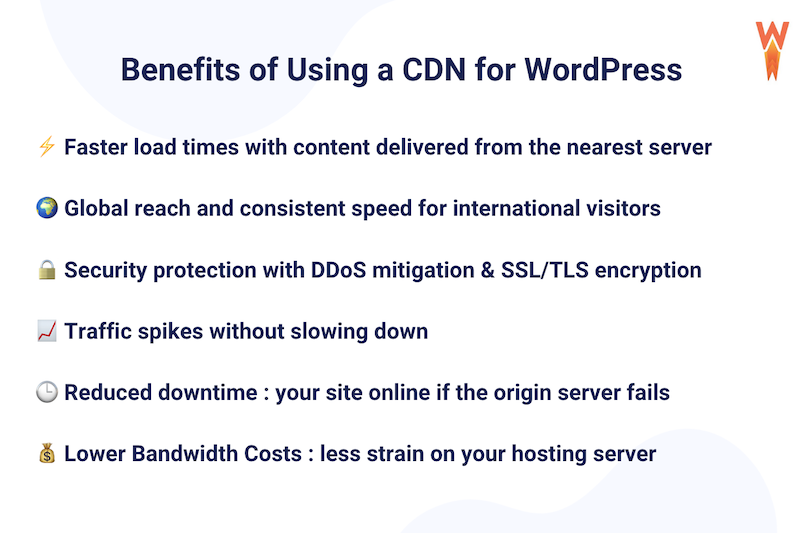
How to Choose the Best CDN: 7 Criteria to Consider
Choose the CDN that aligns with your audience, content type, growth goals, and budget. Whether you want a good CDN performance for WordPress or more advanced CDN security features, these criteria below will help you make the right choice.
1. Performance and User Location
Performance depends on how fast your CDN can deliver content to your visitors, and that is directly linked to the number and placement of Points of Presence (PoPs). Make sure your CDN has multiple PoPs close to your target audience.
On top of that, look for a high Cache Hit Ratio (over 90%), support for modern protocols like HTTP/2 or HTTP/3, and content optimization features to improve performance.
✅ Example: If you target Australia and your CDN only has one PoP in Sydney, visitors in Perth may still experience slower load times. A better choice is a CDN with multiple PoPs in the country for consistent site speed improvement nationwide.
2. Robust Security Measures
With data traveling across servers worldwide, security is essential. Your CDN should support SSL/TLS encryption to protect sensitive data between your site and users. Look for Web Application Firewalls (WAFs), DDoS mitigation, and malware scanning. These features are crucial for eCommerce sites or any website handling logins and personal information.
✅ Example: If you run a WooCommerce store, a CDN with WAF protection and DDoS mitigation keeps your checkout process safe even during an attack.
3. Pricing
Another criterion to consider is the cost of the CDN in relation to your budget. Pricing varies depending on bandwidth and sometimes the amount of traffic you receive. Some CDNs offer flat-rate pricing, while others use a pay-as-you-go model.
✅ Example: If your site gets 50 GB of traffic monthly, a plan capped at 60 GB might be enough, but a viral spike could make a pay-as-you-go plan more expensive than a fixed one. Make sure to choose wisely.
4. Ease of Integration and Compatibility with WordPress
Make sure to focus on your CDN integration with WordPress. Check whether the provider offers a dedicated plugin that simplifies setup (handling tasks like CNAME configuration) and works seamlessly with your WordPress caching plugins, code optimization, and image compression tools.
✅ Example: WP Rocket integrates directly with RocketCDN in the dashboard, making CDN speed optimization effortless.
5. Scalability and Traffic Handling
Your CDN should handle both your current traffic and any future growth. Consider how it scales during sudden spikes.
✅ Example: If a promotion increases your traffic from 2,000 to 50,000 visitors in a week, your CDN should automatically scale to maintain WordPress site performance without downtime.
6. Support and Reliability
Choose a provider with responsive, knowledgeable support available when you need it. Read independent reviews and check if they offer trials or money-back guarantees to test the CDN benefits for WordPress before committing.
✅ Example: If speeds drop after integration, quick access to live chat or phone support can save days of troubleshooting.
7. User-Friendly Dashboard
Your dashboard should make it easy to manage settings, purge cache, and access analytics. Look for reporting on cache hit ratio, user location, and load time improvements.
✅ Example: A dashboard showing real-time traffic by PoP helps you understand where visitors are and how effectively your CDN is serving them.
How to Test CDN Performance
The best way to test CDN performance is to use GTmetrix, because it allows you to choose a specific testing location. For example, if your site is hosted in Paris (origin server) but you want to know how fast it is for visitors in Sydney, GTmetrix can simulates run the test from Sydney before and after enabling your CDN.
Step 1: Pause Your CDN and Measure Your KPIs
When your CDN is paused or deactivated, follow the steps below:
- Go to GTmetrix and create an account.
- Set the test location to your target area (e.g., Sydney).
- Measure the KPIs listed below.
Here are the CDN performance metrics to track before activating your CDN:
That’s the total time to load a web page fully.
Target: under 3 seconds, and it should decrease after enabling a CDN.
Tools: GTmetrix, Pingdom, WebPageTest.
- RTT (Round Trip Time)
It measures the time for a request to travel from the browser to the server and back.
Target: under 100 ms. After using a CDN, this number should decrease.
Tools: Pingdom, WebPageTest.
- Time to First Byte (TTFB)
It’s the time it takes from the browser request to receiving the first byte of data from the server.
Target: under 200 ms and it should decrease with a CDN.
Tools: GTmetrix, PageSpeed Insights, WebPageTest.
- Largest Contentful Paint (LCP)
A Core Web Vital that measures the time until the largest visible element loads. Target: under 2.5 seconds.
Tools: PageSpeed Insights, GTmetrix.
- Bandwidth Usage
That’s the Total data transferred between the CDN and users. Lower is better.
Tools: your CDN dashboard.
- Cache Hit Ratio
This is the percentage of requests served directly from the CDN cache instead of your origin server. A higher ratio means your CDN is effectively delivering cached content without relying on the origin.
Note: This metric cannot be compared before and after CDN activation since it only applies once the CDN is running. Instead, use it as a target to answer the question: “Is my CDN effective?”.
Target: above 90%.
Tools: your CDN dashboard.
Step 2: Reactivate Your CDN
Once you’ve measured the metrics without a CDN, turn it back on.
| 💡 Hint: To confirm your CDN is active, check your site with Google PageSpeed Insights or GTmetrix; you should pass the audit ”Use a Content Delivery Network (CDN)”. You can also inspect network requests via Chrome DevTools to confirm they’re being served from your CDN’s domain. |
Step 3: Test Again and Compare
Run the same tests again with your CDN active. Compare the results in your table. Lower values for RTT, TTFB, LCP, response time, bandwidth usage, and page load time indicate that your CDN is working effectively.
Common Mistakes to Avoid When Choosing a CDN
Even the best CDNs for WordPress won’t deliver results if they’re not set up or chosen correctly. Here are some common mistakes to avoid and what you can do instead.
1. Choosing a CDN with a Non-Intuitive Setup
Some CDNs can be complex to configure, especially when it comes to advanced options like security rules and caching policies. If you’re not comfortable with technical settings, this can lead to misconfigurations and poor results.
✅ Solution: Choose a CDN that handles the technical setup for you. Some CDNs, like RocketCDN, automatically configure caching and apply security features without manual intervention.
2. Setting Up the Cache Incorrectly
A CDN’s caching strategy has a direct impact on WordPress site performance. Misconfigured caching can lead to outdated content being served or frequent cache misses.
✅ Solution: Set appropriate TTL (Time to Live) for different resources. Assets like images or videos can have longer TTLs, while HTML, CSS, and JavaScript files should have shorter ones. You can also use cache control headers to manage how edge servers cache resources.
3. Ignoring Your International Audience
Where your users are located has a big impact on which CDN will work best. Choosing one without PoPs near your audience can result in slower delivery.
✅ Solution: Use Google Analytics to identify where your visitors come from and select a CDN with PoPs in those specific regions.
4. Overlooking Compatibility with Other WordPress Tools
Your CDN should work seamlessly with your hosting, caching plugin, and other performance tools like image compression plugins. Incompatibility can cause errors or negate performance gains.
✅ Solution: Check the provider’s documentation and known-issues list before purchasing. Confirm compatibility with your existing setup.
5. Failing to Monitor Performance
A CDN should be actively improving your site speed and efficiency. If it’s not, it can become an unnecessary cost.
✅ Solution: Use the KPIs and methods from the “How to Test CDN Performance” section above. You can also perform A/B testing to see how different configurations impact performance and adjust as needed.
Bonus: Speed Up WordPress with RocketCDN and WP Rocket
RocketCDN can be an excellent starting point for improving WordPress site performance, but it’s only part of the solution. Before using RocketCDN to accelerate all your content delivery worldwide — and before thinking globally — you need a tool that optimizes every part of your site.
For the best results, combine RocketCDN with a powerful WordPress performance plugin like WP Rocket, the easiest and most effective performance plugin for WordPress.
WP Rocket applies 80% of web performance best practices right upon activation, including caching, GZIP compression, lazy rendering, critical image optimization, and file minification for CSS and JavaScript. It helps improve page speed and your Core Web Vitals.
It also includes advanced options such as deferring JavaScript, removing unused CSS – all accessible from an intuitive dashboard without touching a single line of code. Look, all you need to do is check or uncheck a box to activate or deactivate a feature:
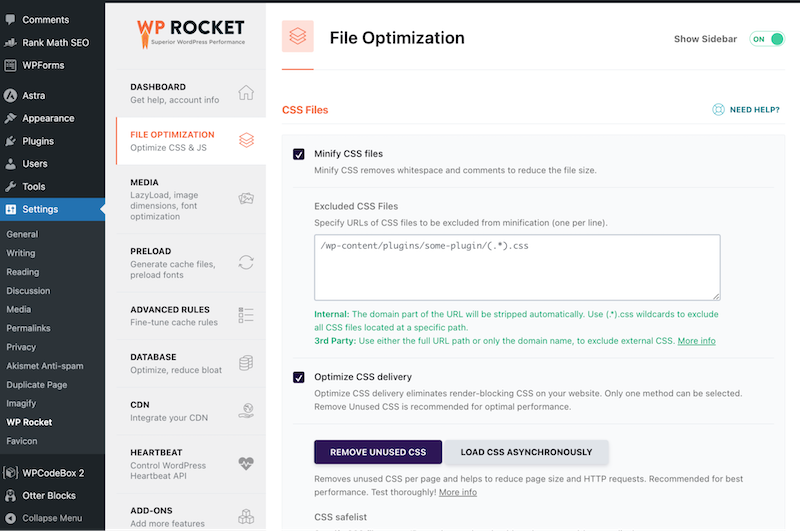
🚀 RocketCDN + WP Rocket: The Perfect Toolbox for WordPress Performance
WP Rocket is powerful for on-site optimization, while RocketCDN accelerates content delivery worldwide. For both tools, no technical setup is ever required: they both handle the heavy lifting for you. They are fully compatible; you can even link RocketCDN directly from the WP Rocket dashboard:

FAQs – Best CDNs for WordPress
What is the best CDN for WordPress?
The best and easiest CDN for WordPress is RocketCDN. It comes with a free WordPress plugin and integrates perfectly with the WordPress ecosystem for smooth CDN speed optimization. There’s no technical setup or fine-tuning required because the plugin handles everything for you automatically.
Does WordPress have a CDN?
No, WordPress does not include a CDN by default when you install it. However, it’s fully compatible with WordPress CDN services like RocketCDN or Cloudflare, which can greatly improve WordPress site performance.
Which CDN is best for a website?
The best and easiest CDN that can improve your website speed in just a few clicks is RocketCDN. It offers access to over 120 Points of Presence (PoPs) worldwide to deliver fast content across the globe with minimal configuration.
How to use a CDN with WordPress?
Most CDNs for WordPress include a free plugin that makes the connection simple. Once activated, the CDN will automatically improve content delivery for your theme, images, plugins, and all static assets on your WordPress site.
Wrapping Up
Now you know what to look for when choosing the best CDN for WordPress: your budget, the number and location of Points of Presence (PoPs), and where your users are in the world. These factors will determine how well your WordPress CDN improves site speed, stability, and user experience.
Here are our 3 recommended options:
- Easy, no technical setup, automatic optimization, but still powerful: RocketCDN.
- More features and advanced security: Cloudflare.
- Image-focused for heavy media like galleries: Envira CDN.
If you are looking for easy tools that do all the heavy lifting for you, then RocketCDN and WP Rocket are your best allies. They are both essential parts of a complete WordPress site speed improvement strategy.
WP Rocket handles on-site optimization like caching, code optimization, lazy rendering, while RocketCDN focuses on accelerating content delivery worldwide. Together, they cover every step needed to make your site faster for both local and international audiences.
With WP Rocket’s 14-day money-back guarantee and RocketCDN’s 24-hour cancellation option, there’s no risk taken except for making your WordPress site go too fast.



